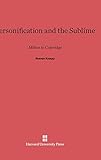Personification and the Sublime : Milton to Coleridge / Steven Knapp.
Material type: TextPublisher: Cambridge, MA : Harvard University Press, [2013]Copyright date: ©1985Edition: Reprint 2014Description: 1 online resource (178 p.)Content type:
TextPublisher: Cambridge, MA : Harvard University Press, [2013]Copyright date: ©1985Edition: Reprint 2014Description: 1 online resource (178 p.)Content type: - 9780674181663
- 9780674181670
- Allegory
- Englische Literatur
- English poetry -- History and criticism
- English poetry
- Literatur
- Personification in literature
- Personifikation
- Sublime, The, in literature
- Technique
- English poetry -- History and criticism
- LITERARY CRITICISM / General
- Personification in literature
- Sublime, The, in literature
- LITERARY CRITICISM / General
- 821/.009/15 19
- PR508.P35 K59 1985
- online - DeGruyter
| Item type | Current library | Call number | URL | Status | Notes | Barcode | |
|---|---|---|---|---|---|---|---|
 eBook
eBook
|
Biblioteca "Angelicum" Pont. Univ. S.Tommaso d'Aquino Nuvola online | online - DeGruyter (Browse shelf(Opens below)) | Online access | Not for loan (Accesso limitato) | Accesso per gli utenti autorizzati / Access for authorized users | (dgr)9780674181670 |
Frontmatter -- Acknowledgments -- Contents -- Introduction -- 1 Coleridge on Allegory and Violence -- 2 Milton's Allegory of Sin and Death in Eighteenth-Century Criticism -- 3 Sublime Personification -- 4 Wordsworth and the Limits of Allegory -- Epilogue: Literal and Figurative Agency in Paradise Lost -- Abbreviations. Notes. Index -- Abbreviations -- Notes -- Index
restricted access online access with authorization star
http://purl.org/coar/access_right/c_16ec
Eighteenth-century and Romantic readers had a peculiar habit of calling personified abstractions "sublime." This has always seemed mysterious, since the same readers so often expressed a feeling that there was something wrong with turning ideas into people--or, worse, turning people into ideas. In this wide-ranging, carefully argued study, Steven Knapp explains the connection between personification and the aesthetics of the sublime. Personifications, such as Milton's controversial figures of Sin and Death in Paradise Lost, were seen to embody a unique combination of imaginative power and overt fictionality, and these, Knapp shows, were exactly the conflicting requirements of the sublime in general. He argues that the uneasiness readers felt toward sublime personifications was symptomatic of broader ambivalences toward archaic beliefs, political and religious violence, and poetic fiction as such. Drawing on recent interpretations of Romanticism, allegory, and the sublime, Knapp provides important new readings of Coleridge, Wordsworth, Kant, and William Collins. His provocative thesis sheds new light on the relationship between Romanticism and the eighteenth century.
Mode of access: Internet via World Wide Web.
In English.
Description based on online resource; title from PDF title page (publisher's Web site, viewed 24. Aug 2021)


